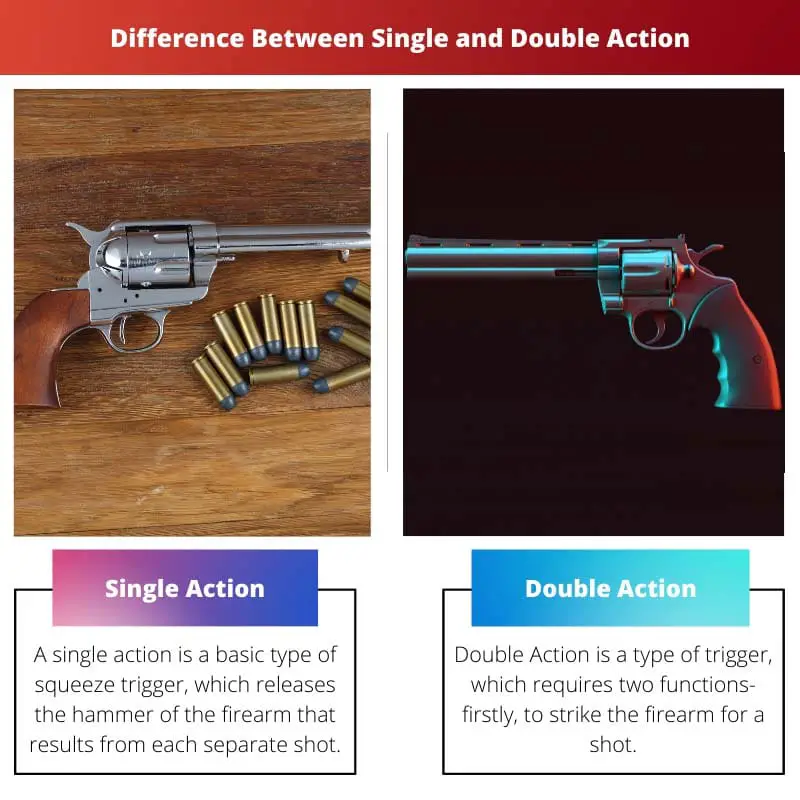In the case of any firearm, an action is a functional mechanism that enables the ammunition cartridge to work
. Furthermore, this type of mechanism has been categorized in numerous ways, such as single action vs. double action, break action vs. bolt action, and many more.
To put it in simple words, the process of breech loading a firearm to fire the ammunition is called an action.
Key Takeaways
- Single-action firearms require manual cocking before each shot, while double-action firearms can fire with a single trigger pull.
- Double-action firearms tend to have a longer and heavier trigger pull, which can affect accuracy.
- Single-action firearms have a faster and lighter trigger pull, making them popular for target shooting and competitions.
Single Action vs Double Action
A single action is a type of trigger where the hammer of a firearm is released resulting from each shot taken. These firearms weigh 4-5 pounds. A double action is a type of trigger which cocks the hammer and then fires the gun. These firearms weigh 5-10 pounds.

Single action is the rudimentary and simplest step of any type of trigger. The terminology single-action denotes the only function of the trigger, which is to release the hammer.
Moreover, single-action is mostly attached to single-shot and repeating long arms like rifles, shotguns, and machine guns.
On the other side of the page, a Double action is also a type of rudimentary mechanism but performs two steps to fire.
The trigger of double action is the combination of double functions, which encloses both the cocking and releasing the hammer. Besides, this type of action is a prerequisite of a trigger-pulling design.
Comparison Table
| Parameters of Comparison | Single Action | Double Action |
|---|---|---|
| Meaning | A single action is a basic type of squeeze trigger, which releases the hammer of the firearm that results from each separate shot. | Double Action is a type of trigger, which requires two functions- firstly, to strike the firearm for a shot. |
| Etymology | The incipient of single-action usage in firearms came in 1872, which was made by William Mason and Charles Brinckerhoff Richards’s Colt’s Manufacturing Company. | Double Action was invented by Robert Adams in 1851. |
| Mechanism | As, single-action operates in single shots, which functions when the trigger is pulled to release the hammer to be cocked subsequently by the fire of cartridges in the chamber. | The mechanism of a double-action works in two functions- one is to hammer and release it in a single row to get the fire shot. |
| Weigh | Single Action firearms weigh around 4-5 pounds. | Double Action weighs heavy, which is estimated at around 4-10 pounds. |
| Example | Colt Single Action was an example of Single action, which was created by the same name- Colt’s manufacturing company. | Taurus PT 92 is a double action that is largely sold in the market. |
What is Single Action?
A Single Action trigger is the most rudimentary type of trigger that has only one function to perform- to release the hammer or striker of the firearm.
Following the release of the hammer, it will be cocked by separate shots. Before the invention of double action, most triggers were single actions.
Eventually, the term Single Action has been in use since the mid-19th century.
These triggers don’t require a person to physically operate the trigger mechanism but to just squeeze the trigger. Single action is used in revolver triggers for firing.
Originally, the usage of Single Action in firearms was manufactured by Colt’s Manufacturing Company in 1872 by William Mason and Charles Brinckerhoff Richards.
The single-action process takes place when the trigger is pulled to release the hammer, followed by the firing of cartridges in the chamber.
These triggers are manually operated prior to each shot. Single action is a very light weapon weighing around 4-5 pounds. For instance, 241 Pistol Single Shot 410-inch Caliber This Belgian is a single action weapon.

What is Double Action?
On the other hand, double action is a type of firearm trigger that involves two functions. It neither has an internal sear mechanism to hold the hammer in position, nor the whole hammer shrouded with a thumb spur design in its weapons.
Double action requires the design of trigger pulling, where everything remains in position until the trigger is pulled.
Robert Adams is the patent of the first double-action revolver, and he invented this type of trigger in 1851 to fire at a greater rate than any single-action gun does.
Unlike portable single-action guns, double-action weapons are quite long and heavy, weighing around 9-10 lbs. Taurus PT 92 is one of the widely renowned double-action guns.

Main Differences Between Single and Double Action
- Single action is a basic trigger that requires one step to pull the shot, whereas Double action is a two function of a firearm to release a shot.
- Single action was introduced in 1872 by William Mason and Charles Brinckerhoff Richard. Meanwhile, Double action was introduced in 1851 by Robert Adams.
- Single action operates by pulling the trigger, which releases the hammer to be cocked notwithstanding, Double action functions in two steps.
- Single Action weighs 3-4 pounds, but Double action is heavy to carry and is estimated to weigh around 4-10 pounds.
- There are Colt, 241 Pistol, and 410-inch Caliber as examples of single-action firearms. On the contrary, the Taurus PT 92 is famously known as a Double-action firearm.

I think this article does a poor job at explaining the differences, and the choice between single and double action triggers is much more complex than what’s described here.
While I understand your point of view, I believe the article did a good job at simplifying a complex subject and making it understandable for all readers.
The choice of single or double action is crucial in any firearm, this article does a great job of explaining the differences and considerations.
I couldn’t agree more, choosing between single and double action triggers is an important decision, and it’s great that the article provides such clear explanations.
The article delivers an excellent comparison between single and double action firing mechanisms, very informative and interesting.
I couldn’t agree more, the depth of comparison in the article is truly enlightening.
I respectfully disagree, the article seems quite basic in its comparison and lacks detailed insights.
I think the article falls short of providing a comprehensive explanation of the topic, and fails to go into enough detail about the differences between single and double action.
The article could have been more informative, while it provides a general understanding, it lacks in-depth analysis.
I share your opinion, the article could benefit from a more thorough examination of the subject.
I believe the article offers a concise and clear explanation of the topic, and it’s sufficient for the needs of most readers.
The article provides a good overview of single and double action firearms, and the historical context is very interesting.
This article provides a deep insight into the history and mechanisms of single and double action firing, really great work!
This article does a great job at explaining the mechanisms and the differences between single and double action triggers, great source of information!
I completely agree, this is a very well-researched and written article on the topic.
I disagree, the article seems to oversimplify the topic and fails to provide a critical analysis of the different types of triggers.